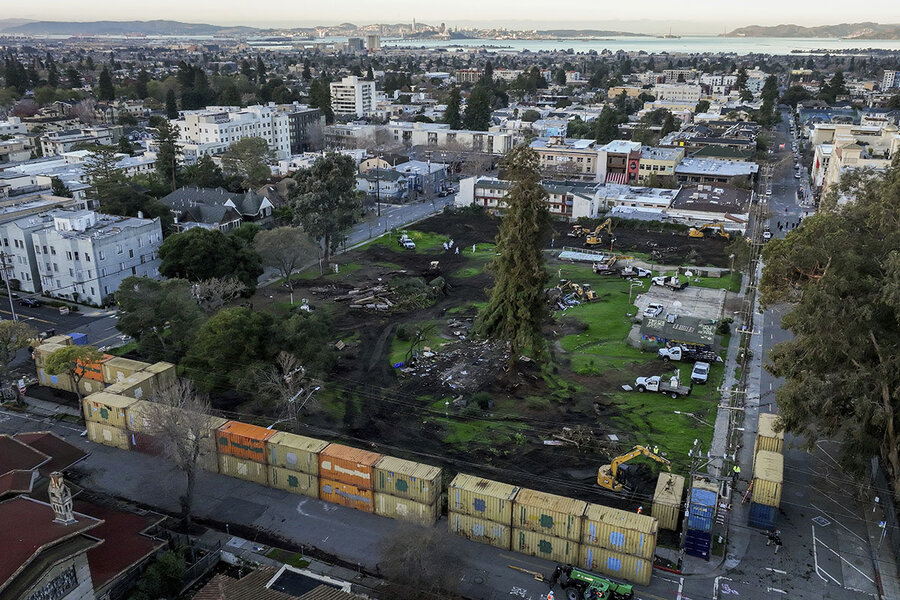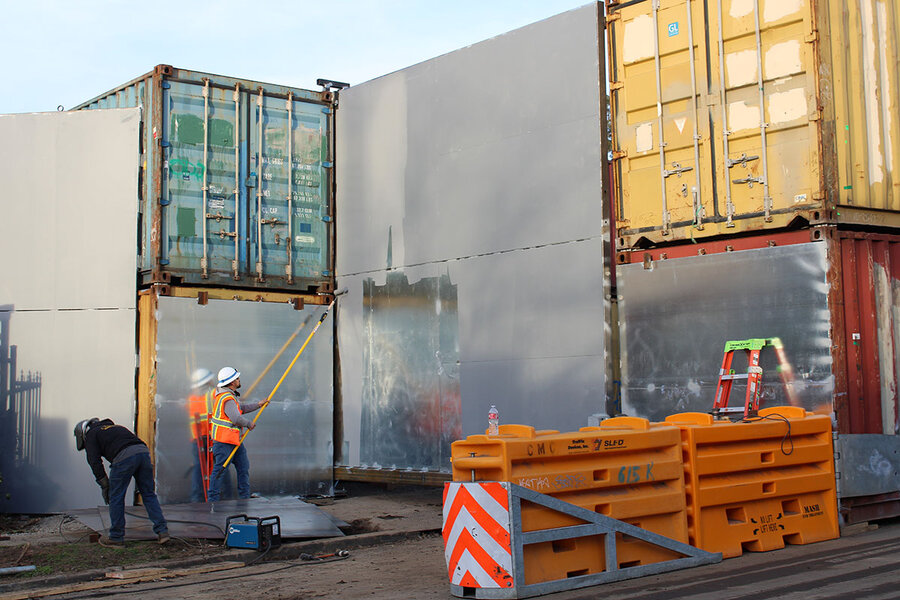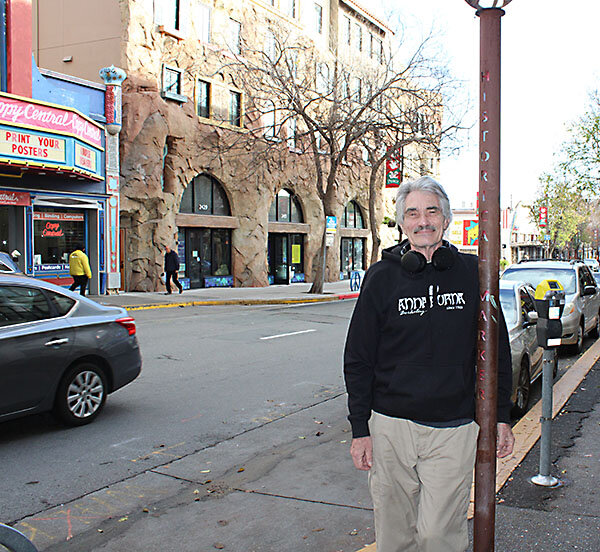Letter from Berkeley: Requiem for People’s Park
Loading...
| Berkeley, Calif.
Billy Simpson can’t imagine Berkeley without People’s Park. The iconic park in this California college town was where he grew up playing. “That park is like, it’s freedom,” says Mr. Simpson. “It’s just love.”
Shipping containers now line the park’s perimeter, blocking public access. A decadeslong power struggle over the best use of People’s Park came to a head last week, when the University of California, Berkeley, the park’s owner, cleared it of unhoused residents and erected the container wall.
Why We Wrote This
People’s Park – Berkeley’s iconic gathering spot, founded in the 1960s – sits on valuable real estate in the heart of the university town. Plans to develop on the site raise questions about public space and what’s best for a community.
The move secures the site for a university housing development, long held up by protests, vandalism, and legal challenges.
“We are going to open up a beautiful building and a beautiful new public park space that will be for the enjoyment of everyone,” says Kyle Gibson, a UC Berkeley spokesperson.
That vision faces opposition and doubters. Many locals now feel squeezed out. And nearby shop owner Al Geyer sees the new development as part of an effort to “defunkify” Berkeley.
Still, the park’s zeitgeist of acceptance is what defenders hold to.
“They can’t build the wall between us,” says Jen, a local resident who did not give her last name, citing privacy concerns. “Because we’ve already created these connections.”
Billy Simpson can’t imagine Berkeley without People’s Park. The iconic park in this California college town was where he played growing up. As he got older, he made some of his best friends there. When he worked in food delivery, he would bring canceled orders to unhoused residents who found rest there.
“That park is like, it’s freedom. It is what Berkeley used to be,” says Mr. Simpson. “It’s just love.”
People’s Park inspired Krista McAtee to attend the University of California, Berkeley three blocks away. The fifth-year student gets emotional recalling her first visit as a 13-year-old on a campus tour with her family. She returned home to Southern California, decorated a jean jacket with “power to the people,” and set her sights on the school.
Why We Wrote This
People’s Park – Berkeley’s iconic gathering spot, founded in the 1960s – sits on valuable real estate in the heart of the university town. Plans to develop on the site raise questions about public space and what’s best for a community.
“This idea of community, this idea of taking care of one another,” says Ms. McAtee, “are values that I learned from being at People’s Park.”
Shipping containers line the park perimeter now, blocking public access. A decadeslong power struggle over the best use of People’s Park came to a head last week, when UC Berkeley, which owns the park, cleared it of unhoused residents and erected the container wall. The move secures the site for a long-planned university housing development that has been held up by protests, vandalism, and legal challenges.
“This is not a forever installation,” says Kyle Gibson, a UC Berkeley spokesperson. “This is going to be here through construction, and when we are done, we are going to open up a beautiful building and a beautiful new public park space that will be for the enjoyment of everyone.”
That vision faces opposition and doubters. But tension has always been part of the park’s origin story.
Everyone welcome
People’s Park emerged in 1969, two years after the university bought it for dorm space and then left it vacant. A local paper suggested people should meet there, and they did. It became a community gathering place; people put in gardens, a pond, and a playground. But the school tore it all out a month later, leading to protests that culminated with then-Gov. Ronald Reagan sending in the National Guard.
Throughout the years, the university made sporadic attempts to regain control of the park, but it remained open to the community. People’s Park became a refuge – for protesters, philosophers, artists, students, residents housed and unhoused. It was a place where anyone who needed it could go for help.
“There’s a very big lack of community spaces in the modern age. And that’s what People’s Park used to be,” says UC Berkeley student Esther Choi. “Now it’s gone.”
That demise has weighed on advocates for the housing development, too, which include Berkeley’s mayor, City Council, and state lawmakers. The plan took five years to develop, with input from local organizations, neighbors, students, and officials. “The park represents many things to many people,” says Mr. Gibson, who points out that plans “reflect that history in the new design.”
Today the 2.8-acre park is on the National Register of Historic Places, surrounded by historic homes and churches noted for their architecture.
Plans for the new development include 1,100 student housing units and more than 100 supportive housing units, while preserving 60% of the open space. They also commemorate the park’s history and offer unhoused residents transitional housing, a community-led drop-in center, and a dedicated social worker. Construction is on hold while the state Supreme Court considers whether it violates environmental regulations.
Everyone agrees there’s a critical need for housing. University enrollment is up 26% compared with 10 years ago, and rising costs have added to the squeeze. The People’s Park project is part of a broader school initiative to double student housing with 9,000 new beds across 14 sites throughout the city.
Safety is an issue, too. The park has long provided rest for people with nowhere to go. But during the pandemic, overnight restrictions were lifted, enabling homeless encampments. Crime and drug use increased, although opponents say it’s a challenge the university created through neglect; in the last few years, it closed the park’s public restrooms and removed trash cans, trees, and gardens.
“Who are they kidding?” asks Harvey Smith, president of the People’s Park Historic District Advocacy Group, referring to Berkeley administrators. “This is an institution that has run three national nuclear laboratories. Who’s going to believe that they actually can’t maintain in beautiful condition the 2.8-acre park? It’s crazy talk.”
Damp hope
Rain drizzled down on Telegraph Avenue earlier this week, adding a chill to the tone of defiance – or resignation, depending on who’s asked - that blankets the park. The avenue runs a block off the park, right up to campus, where many of the shops and restaurants lining the street are entwined with Berkeley counterculture.
Annapurna is one of those iconic shops. Al Geyer opened his store around the time that People’s Park was established, but he, too, feels squeezed out.
He sees the new park development as part of the university’s larger effort to “defunkify” Berkeley amid demographic sea changes. The pandemic gutted retail activity, he notes, providing Berkeley administrators a tipping point. “We lost all the stores, and they’ve done nothing,” he says. “They’re happy to have this as a base moment, where you clean the counter off and you start from scratch.”
Mr. Geyer recalls the park’s early days when he supported it with window displays. Protesters protected his property. “They would stand in front and say, ‘Do not harm Annapurna, because we’re open to the working man, to multiculturalism,’” says Mr. Geyer. Even if parkgoers didn’t buy from him, they were welcome to browse his store or rest out front.
For now, that spirit of acceptance and mutual support is what park defenders are holding on to.
“If it does get taken from us, people will still gather,” says Jen, a local resident who did not give her last name, citing privacy concerns. She works with the park’s mutual aid group. “They can’t build the wall between us because we’ve already created these connections.”
Editor's note: A sentence in this article has been updated to clarify that a source named Jen did not wish to have her last name published.











